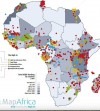After the launch of ZACube-1 in 2013 and ZACube-2 in 2018, South African space research will soon be enriched with new nanosatellites. They will help the country achieve the goals of its new space strategy.
The Cape Peninsula University of Technology (CPUT), based in Cape Town, will launch a constellation of three nanosatellites into space by the end of 2021. The equipment which is being assembled will be used for surveillance of the national maritime domain.
Dubbed MDASat-1 for Maritime Domain Awareness, the constellation will use data from the Automatic Identification System (AIS) to monitor navigation movements in South African waters.
“MDASat-1 is a major achievement and milestone for CPUT, South Africa and the continent as a whole, not only by providing the government with strategically important vessel tracking data, but also by developing skills and cutting-edge technologies, ”said Robert van Zyl, director of the Africa Space Innovation Center, the innovation center of CPUT.
The CPUT has been interested in satellites since 2013, when it launched its first nanosatellite called ZACube-1, followed in 2018 by ZACube-2, used respectively for space weather research and maritime surveillance. Its interest in satellites is in line with the objectives of the new space strategy 2020-2025, which makes space research a pillar of national development.
Through the MDASat-1 constellation, South Africa will have the capacity and know-how to acquire vital information that will break its reliance on data from foreign companies.
The data collected by the nanosatellites will be used by the government for better management of its exclusive economic zone, said Robert Van Zyl.
Source Ecofin Agency
































Réagissez à cet article